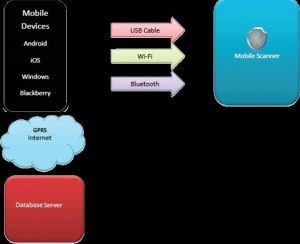
On routine patrolling one day some police officers spotted two men engaged in some suspicious activity near a very crowded market. The officers questioned them but did not get any satisfactory answers for their presence at the spot. The officers detained the two suspects. On interrogation, they found neither of them had any identity proof and each of them had a different version for them being there. They were arrested and presented before the court; but with no proof of identification or background they managed to get bail. The police officers who had apprehended them were unaware of their terror background.
Such instances like that of the most wanted terrorist Yasin Bhatkal, where he lived assuming different identities in different parts of India have been happening frequently in the recent past.
Modern-day policing methodology has been transformed with the expansion of mobile technology with devices such as laptops, license plate readers, mobile phones, and digital video recorders. The use of mobile technology allows police officers to perform their jobs while on patrol, resulting in more efficiency, accuracy and safety.
In the past several years, Biometric Identity has become standard identity tool in the law enforcement agencies across the nation.
The Automated Fingerprint Identification System (AFIS) is a biometric identification methodology that uses digital imaging to capture a fingerprint, which can then be compared to a database of fingerprint records to help determine the identity of an individual. After a fingerprint image is captured, a biometric template is digitally created, and selected data points of the image are then extracted and interpreted. Next, the template is compared to a searchable database. And generally, within less than a minute the information is processed. Automated fingerprint technology can be used for both identification and verification purposes. Verification is a one-to one comparison (1:1) of a biometric to confirm an individual’s identity, while identification is a one-to-many (1:N) of a biometric, against a database to try and find a match.
When an individual’s fingerprintis scanned for the first time, additional information is also obtained, such as name, and other demographic details. All of his orher personal information is recorded along with the information of any criminal background. If he or she is convicted of any crime, that information is also stored. If that same person’s fingerprint is scanned at a future time, he/she is identified through that information, and then verified through the biometric match.
But the question is how soon the information is accessible?
Many a times, the required information takes too long which aids the criminals to get away from the clutches of law.

Security on the Move
1. Fingerprint are captured via the battery powered Mobile Biometric Scanner and sent to mobile device for verification, identification or enrolment.
2. Mobile device sends the fingerprint to Database Server and brings back the demographic data of the related identity.
3. New demographic data can also be captured using mobile device, and the person can be enrolled/registered on the field.
With advanced technology same crime could have been handled thus ……
The officers detain the two suspects. Within seconds of capturing the fingerprints, a “verify” response is received on the mobile AFIS. The handheld clearly displays the individual, along with name, demographics, criminal history and an outstanding arrest warrant. The arrested suspects were two of the most wanted terrorists. They were arrested and presented before the court; with a trail of all their criminal records.
Smartphone driven Biometric Verification Device (SBD) is an innovative technology and provides biometric hardware and software solutions primarily in mobile domain and convert the existing mobile phones/tablets into powerful biometric devices. SBD provide mobile biometric identity verification solutions with accurate identity enrolment, identification and verification, anytime and anywhere in a most cost effective manner. The compact hand held fingerprint scanner uses wireless technology for rapid identity verification in challenging environments.

 Smartphone driven Biometric Verification Device (SBD) is a compact, hand held device that links via Bluetooth, USB cable or even Wi-Fi to a compatible,software loaded, pre-configured smartphone. It works with a wide range of Android devices from any cellular service provider, iOS, Windows, Linux and Macintosh. It captures forensic quality fingerprint images for transmission to remote Biometric (Finger print) databases for fast and accurate identification of unknown subjects. Equipped with compact handheld devices and smartphone, police officers can capture an individual’s fingerprint and submit it to a searchable database for a possible match, all from the site/ crime scene and that too in a matter of seconds.
Smartphone driven Biometric Verification Device (SBD) is a compact, hand held device that links via Bluetooth, USB cable or even Wi-Fi to a compatible,software loaded, pre-configured smartphone. It works with a wide range of Android devices from any cellular service provider, iOS, Windows, Linux and Macintosh. It captures forensic quality fingerprint images for transmission to remote Biometric (Finger print) databases for fast and accurate identification of unknown subjects. Equipped with compact handheld devices and smartphone, police officers can capture an individual’s fingerprint and submit it to a searchable database for a possible match, all from the site/ crime scene and that too in a matter of seconds.
This technology is also suitable for other application areas:
- Law Enforcement Agencies (Police forces across the country)
- Defence and Border Control
- Nation Identification Programs
- Health Care
This technology has been exclusively developed by Square Advisors Pvt. Ltd. keeping in mind the requirement of technology driven policing which will aid the law enforcement for quick identification and speedy trials.
With this advanced technology, the databases of the wanted criminals, terrorists and regular offenders can be accessed from any corner of the country irrespective of region or state. Wanted terrorists Yasin Bhatkal could have been nabbed with the use of this technology when he was first apprehended in 2008 by West Bengal Police.
Nisha Menon (PG DCL & FSc., MSc.) Forensic Expert, Technical Head, Square Advisors Pvt. Ltd. (The nex-gen in Forensic,Security and Investigation)













